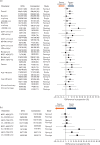Dolutegravir efficacy at 48 weeks in key subgroups of treatment-naive HIV-infected individuals in three randomized trials
- PMID: 25387312
- PMCID: PMC4284010
- DOI: 10.1097/QAD.0000000000000519
Dolutegravir efficacy at 48 weeks in key subgroups of treatment-naive HIV-infected individuals in three randomized trials
Abstract
Objectives: Dolutegravir (DTG) has been studied in three trials in HIV treatment-naive participants, showing noninferiority compared with raltegravir (RAL), and superiority compared with efavirenz and ritonavir-boosted darunavir. We explored factors that predicted treatment success, the consistency of observed treatment differences across subgroups and the impact of NRTI backbone on treatment outcome.
Design: Retrospective exploratory analyses of data from three large, randomized, international comparative trials: SPRING-2, SINGLE, and FLAMINGO.
Methods: We examined the efficacy of DTG in HIV-infected participants with respect to relevant demographic and HIV-1-related baseline characteristics using the primary efficacy endpoint from the studies (FDA snapshot) and secondary endpoints that examine specific elements of treatment response. Regression models were used to analyze pooled data from all three studies.
Results: Snapshot response was affected by age, hepatitis co-infection, HIV risk factor, baseline CD4⁺ cell count, and HIV-1 RNA and by third agent. Differences between DTG and other third agents were generally consistent across these subgroups. There was no evidence of a difference in snapshot response between abacavir/lamivudine (ABC/3TC) and tenofovir/emtricitabine (TDF/FTC) overall [ABC/3TC 86%, TDF/FTC 85%, difference 1.1%, confidence interval (CI) -1.8, 4.0 percentage points, P = 0.61] or at high viral loads (difference -2.5, 95% CI -8.9, 3.8 percentage points, P = 0.42).
Conclusions: DTG is a once-daily, unboosted integrase inhibitor that is effective in combination with either ABC/3TC or TDF/FTC for first-line antiretroviral therapy in HIV-positive individuals with a variety of baseline characteristics.
Figures
References
-
- US Department of Health and Human Services Panel on Antiretroviral Guidelines for Adults and Adolescents. Recommendation on integrase inhibitor use in antiretroviral treatment-naive HIV-infected individuals. http://aidsinfo.nih.gov/news/1392/hhs-panel-on-antiretroviral-guidelines... [Accessed 16 December 2013]
-
- Branas F, Berenguer J, Sanchez-Conde M, Lopez-Bernaldo de Quiros JC, Miralles P, Cosin J, et al. The eldest of older adults living with HIV: response and adherence to highly active antiretroviral therapy. Am J Med 2008; 121:820–824. - PubMed
-
- Kumar PN, Rodriguez-French A, Thompson MA, Tashima KT, Averitt D, Wannamaker PG, et al. A prospective, 96-week study of the impact of Trizivir®, Combivir®/nelfinavir and lamivudine/stavudine/nelfinavir on lipids, metabolic parameters and efficacy in antiretroviral-naive patients: effect of sex and ethnicity. HIV Med 2006; 7:85–98. - PubMed
-
- Tedaldi EM, Absalon J, Thomas AJ, Shlay JC, van den Berg-Wolf M. Ethnicity, race, and gender. Differences in serious adverse events among participants in an antiretroviral initiation trial: results of CPCRA 058 (FIRST Study). J Acquir Immune Defic Syndr 2008; 47:441–448. - PubMed
-
- Rockstroh J, Teppler H, Zhao J, Sklar P, Harvey C, Strohmaier K, et al. Safety and efficacy of raltegravir in patients with HIV-1 and hepatitis B and/or C virus coinfection. HIV Med 2012; 13:127–131. - PubMed
Publication types
MeSH terms
Substances
Grants and funding
LinkOut - more resources
Full Text Sources
Medical
Research Materials



